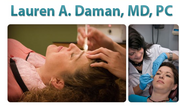Hiding Spider Veins? Get Gorgeous Legs With Hartford’s Leading Dermatologists

What comes to mind when you think about dermatology? You may be surprised to learn how extensive the field is. Based in Hartford and Simsbury, CT, the offices of Lauren A Daman, MD, PC offer a wide range of treatments and services that improve the appearance of skin from head to toe. These treatments range from topical services including microdermabrasion and chemical face peels to more intensive procedures such as scar removal and the reduction of spider veins. Dr. Daman and her team of highly trained dermatologists understand that clear skin is about more than just beauty—it’s about maintaining your health and being able to feel as good as you look.

Have you noticed small red or blue veins appearing on your legs? If so, you may be experiencing spider veins—small, dilated blood vessels that are close to your skin and occur most commonly in the legs. Spider veins are a common issue for both women and men and are caused by increased pressure in the blood vessels. This increased pressure has a number of causes, including standing for long periods of time, weight gain, and even increased blood flow during pregnancy. Spider veins should not be confused with varicose veins, which are larger and often have a twisted or bulging appearance that raises the veins above the skin’s surface. Varicose veins may also become swollen or painful over time, and these symptoms should be reported to a physician.
Spider veins, however, are typically not painful and are considered more of a cosmetic concern. If the presence of these veins leaves you feeling dissatisfied with the appearance of your skin, Dr. Daman and her staff can help. The two most common methods of treating spider veins are sclerotherapy and laser therapy. Sclerotherapy reduces the appearance of spider veins by collapsing them. Patients using this method receive an injection into the affected vein that will cease blood flow into that vein, causing it to collapse; the vein then fades much in the way a scar would. In cases where the spider veins are very fine and difficult to inject, laser therapy is the recommended course of treatment.

Both treatment methods will likely require more than one session for the best results, with most patients seeing a 50% to 90% improvement in the appearance of their skin. It is also important to develop good habits to prevent the future development of spider veins, especially when it comes to doing exercises that improve leg strength and maintaining a low-sodium, high-fiber diet. Your dermatologist may also recommend compression garments to control swelling and offer support between treatment sessions.
To learn more about treating spider veins, as well as a wide range of other skin conditions, call the office of Lauren A Daman, MD, PC at (860) 246-3533 and schedule a consultation today. Be sure to also visit their website to see a complete list of available services.
About the Business
Have a question? Ask the experts!
Send your question

